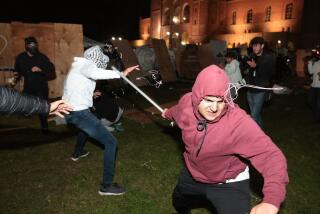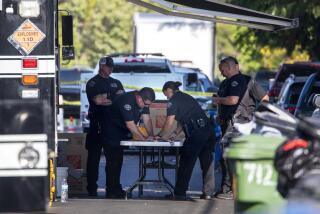Video images yield two possible Boston bombing suspects
- Share via
BOSTON — Authorities have obtained clear images of the faces of two men with backpacks who they believe were acting suspiciously around the time of the Boston Marathon bombings, a potential breakthrough in the search to find who planted the deadly devices, sources familiar with the investigation said Wednesday.
A department store surveillance camera caught an image of at least one of the men leaving a backpack near the finish line, a federal law enforcement official said.
Another official briefed on the investigation said the image that shows two men is the first indication that more than one bomber may have been responsible for the attacks that killed three people and injured more than 170 at Monday’s race.
PHOTOS: Explosions at Boston Marathon
The men were singled out because of their demeanor and the way in which they reacted to the bomb blasts, said these officials, who could not be identified because they were not authorized to discuss the investigation publicly. Neither would say how close authorities were to identifying the two.
The photographic evidence adds to physical evidence already gathered at the scene, including parts of a pressure cooker probably used in the two bombs that went off as hundreds of runners were still streaming in five hours into the race.
Authorities are relying not only on extensive surveillance video but a flood of photos and videos sent in by spectators, office workers and others who were at the disaster scene near Copley Square.
“I think that this will go down in U.S. history as the most videotaped bombing in history,” said Tom Thurman, who formerly headed the FBI’s Bomb Data Center and helped investigate the 1988 bombing of Pan Am Flight 103 over Lockerbie, Scotland, and the 1993 bombing of the World Trade Center.
On Thursday, President Obama was scheduled to speak at an interfaith service here for the victims, 59 of whom are still hospitalized, with 10 in critical condition. The third victim killed has been identified as Lu Lingzi, 23, a Chinese national who was a Boston University graduate student in statistics.
Mayor Thomas Menino and Massachusetts Gov. Deval Patrick announced that attorney Kenneth Feinberg would administer One Fund Boston, a fund set up to aid those affected by the attacks. Feinberg oversaw similar funds for victims of the Sept. 11 attacks and the 2010 BP oil spill.
The disclosures about the photos emerged on a dizzying day of conflicting reports in which a number of news agencies initially reported that a suspect had been identified and arrested, and was supposedly scheduled for a court appearance.
Hundreds of reporters and spectators gathered outside the Joseph Moakley federal courthouse, near Boston’s Seaport district, which was briefly evacuated for a bomb threat even as the FBI and the Boston Police Department denied anyone had been taken into custody.
Federal officials cautioned that the full work of building a case could take time. Law enforcement officers now have access to sophisticated software tools that can use algorithms to search video for specific patterns — colors of clothing, movement or objects, analysts say. The federal Department of Homeland Security has invested heavily in facial recognition software. But it can be tedious work.
“The question that is most often asked is, is there a button we can push to make this happen as quickly as the general public thinks we can, from watching television and movies,” said Larry Compton, operations manager at Forensic Video Solutions Inc., a firm that serves as a consultant to law enforcement.
“The answer is no. These tools and techniques are really designed to focus the analysts,” he said.
The department store video can be compared with images gleaned from more than 10 trillion bytes of data gathered from other sources, including gas stations and ATM and traffic cameras, to see where a person of interest might have been before and after the attack, said one retired federal agent, who spoke on condition of anonymity because he may become involved in the case. “If you’re lucky, you see the person getting into a car, and maybe you can pull a license plate,” he said.
But security videos are typically low-resolution and don’t offer a lot of visual detail, experts say, which helps explain why authorities have appealed to the public for photos and cellphone videos — images with much higher resolution.
“Then you can really blow it up and zoom on in,” said Lance McVickar, president of Lawdio Inc. of Fairmount, N.Y., who has also served as a video consultant in federal investigations. “And a lot of them do time-stamping.… You find a picture with a bag not there and then a picture with a bag there — and then a photo of a person dropping the bag.”
Already, there has been widespread public attention to a photo provided by a viewer to Boston TV station WHDH showing two bundles inside the security barrier next to a trash can — with a subsequent photo showing the immediate aftermath of an explosion at the same location.
Forensic investigators in white protective suits and agents leading sniffer dogs continued Wednesday to collect evidence from the blast sites inside a well-guarded police cordon near Boston’s Copley Square. Agents from the FBI, the Bureau of Alcohol, Tobacco, Firearms and Explosives and other agencies moved back and forth from the crime scene along Exeter Street, a narrow artery leading from the marathon route down Boylston Street, which was lined with mobile labs and bomb-disposal trucks.
DNA could be found on a detonator or circuit board; wires could be linked to wire cutters found in a suspect’s home; serial numbers could help trace a purchase point for materials.
“They’re absolutely going to continue the residue sampling to determine what type of explosives were used. That’s really important right now,” Thurman said.
After U.S. Judge Robert Vance was killed by a mail bomb at his Alabama home in 1989, Thurman and hundreds of federal agents spent more than a year scouring a well-contained crime scene — Vance’s home — before they were confident they had identified a suspect.
“They stay on the scene for an extended period to get all recoverable pieces,” Thurman said. “This is not in the scheme of things a huge bombing. Even though it’s outside, they secured the scene quickly. So they will stay there till they find the materials.”
Officials said that the FBI and more than 30 other state and federal law enforcement agencies were involved in the case, and that more than 1,000 law enforcement agents had been assigned to it.
“It takes a tremendous amount of resources,” Thurman said. “It’s a huge job, it really is. But it’s totally doable.”
Dilanian reported from Washington, Serrano from Las Vegas and Tanfani from Boston. Times staff writers Shashank Bengali and Molly Hennessy-Fiske in Boston and Kim Murphy in Seattle contributed to this report.
More to Read
Sign up for Essential California
The most important California stories and recommendations in your inbox every morning.
You may occasionally receive promotional content from the Los Angeles Times.













